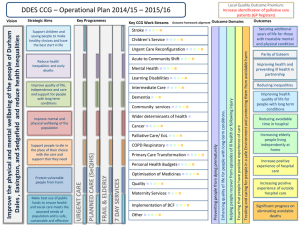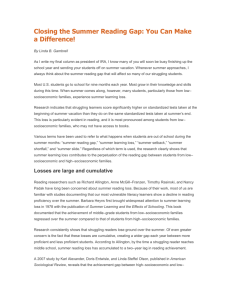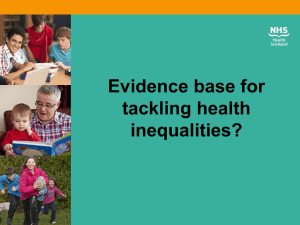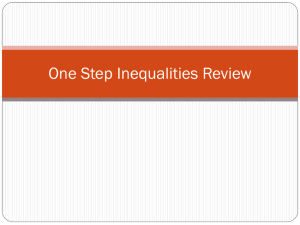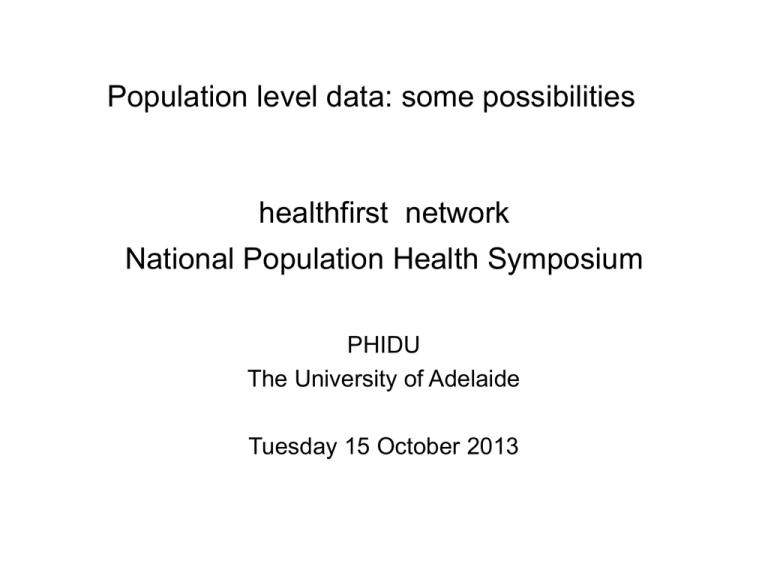
Population level data: some possibilities
healthfirst network
National Population Health Symposium
PHIDU
The University of Adelaide
Tuesday 15 October 2013
Population Health Data:
A guide to its use for needs assessment
by Divisions of General Practice
Introduction to population health
1.1 What is ‘population health’ in the context of general
practice?
1.2 What determines the health and wellbeing of the Australian
population?
1.3 Chronic diseases and their risk factors in Australia
1.4 Role of Divisions in population health needs assessment
1.5 Principles underpinning needs assessment
1.6 Engaging with other stakeholders
1.7 Assessing a Division’s capacity to undertake needs
assessment
1.8 Summary of the steps involved in undertaking a health
needs assessment
Using population-level health data
2.1
2.2
2.3
2.4
2.5
2.6
2.7
What are population-level health data?
What uses can be made of these types of data?
How to use population health data for needs assessment
Possible barriers to the use of population health data
Developing a population profile
Population health data sources and their accessibility
Examples of using data for population health needs
assessment
Population health, in the context of general
practice, is thus defined as:
“The prevention of illness, injury and disability,
reduction in the burden of illness and rehabilitation of
those with a chronic disease. This recognises the
social, cultural and political determinants of health. This
is achieved through the organised and systematic
responses to improve, protect and restore the health of
populations and individuals. This includes both
opportunistic and planned interventions in the general
practice setting.”
A Joint Consensus Statement of the General Practice Partnership Advisory Council and the National Public
Health Partnership Group (Joint Advisory Group on General Practice and Population Health 2001)
‘From a general practice perspective, (population health) can
be seen as an extension and systemisation of the general
practice’s existing role in preventive care for individual
patients. As well, it is the provision of more comprehensive
preventive care that addresses the needs of the practice’s
patients and local communities, that is, including those not
adequately accessing preventive care. It involves activities,
such as immunisation, risk assessment and management,
patient education and screening, in which GPs are already
engaged within their practice, it also involves notification of
diseases of public health importance to the relevant
government agency … Population health represents an
extension and expansion of existing clinical roles towards
an emphasis on prevention and a focus on groups or
populations rather than on individual patients. General
Practice also has an important advocacy role around the
structural issues that affect health status, especially for
socially disadvantaged groups. This role will vary
according to the setting and may be appropriate at Division
or other levels.’
(Joint Advisory Group on General Practice and Population
Health 2001).
Key influences or determinants of health
Health inequalities
Overall high level of health and wellbeing in Australia e.g., life
expectancy and infant mortality rates.
However, there are substantial differences, or ‘inequalities’, in
the health and wellbeing of specific groups within the
population, e.g.,
- Aboriginal people; and
- other socioeconomically disadvantaged groups, such as single
parents on low incomes, the long-term unemployed, recently
arrived refugee families, people with significant long-standing
mental health problems, and those who have a disability, or are
homeless or have only temporary accommodation.
Socioeconomic inequalities in health
The lower a person’s SES, the shorter their life expectancy and
the more prone they are to a wide range of chronic diseases and
conditions.
The link between SES and health begins at birth and continues
through life, but the strength of the relationship varies at different
life stages.
It is also likely that the health effects of SES through a person’s
life are cumulative.
However, there is much more to the link between SES and health
than the effects of poverty and adversity. In fact, health improves
with each step up the SES ladder.
Socioeconomic inequalities in health
Socioeconomic inequalities in health
State/ Territory
NSW
Vic
Qld
SA
WA
Tas
NT
ACT
1987
338.1
348.8
342.1
324.2
353.0
407.8
325.7
303.3
2007
267.8
270.3
304.2
315.9
296.8
334.6
792.8
252.1
Year in which rate in Quintile 5 fell below
1
the 1987 Quintile 1 rate
1998
1998
2003
2006
1998
1997
Not yet achieved
2000
Socioeconomic inequalities in health
Socioeconomic inequalities in health
Chronic diseases and their risk factors
In Australia, as elsewhere, the prevalence of chronic disease
varies across the socioeconomic gradient for a number of
specific diseases, as well as for important disease risk factors
However, the diseases with substantial disparities across the
socioeconomic quintiles are different, for different stages in
the life course.
Any health interventions to address the impact of chronic
disease and associated risk factors, at a population level,
need to take socioeconomic inequalities into account.
Prevalence of Type 2 diabetes
Rate ratios (Most/ Least disadvantaged)
2001:
2.39
2011-12: 2.19
Source: ABS National Health Surveys
Smoking rates
Rate ratios (Most/ Least disadvantaged)
2001:
1.87
2011-12: 2.33
Source: ABS National Health Surveys
Obesity rates
Rate ratios (Most/ Least disadvantaged)
1995:
1.34
2007-08: 1.80
2011-12: 1.63
Source: ABS National Health Surveys
What are population-level data
A ‘population’ may refer to:
- all the members of a particular group (such as, all Aboriginal
children from birth to 12 years); or
- all Australian citizens; or
- all registered voters residing in a particular postcode; or
- all hypertensive patients attending a general practice clinic.
In general, a population is the number of people, by age and
sex, living in a geographic area. A population’s size and
age/sex composition impact upon the health status of a region
and its need for health services
What are population-level data …cont
For health needs assessment, a population can be
identified as people sharing:
- Geographic location – e.g., living in a neighbourhood or
catchment area); or
- Setting – e.g. school, workplace, prison or hospital; or
- Social experience – e.g. age, ethnicity, homelessness;
- Experience of a health condition – e.g. certain disease,
mental illness or physical disability.
What are population-level data …cont
Major types of data (total pop, pop by age & sex; marital
status; family type; labour force etc.)
Data characteristics
- Temporal: for selected years, a time period (e.g. a decade),
projected demographic data to a future date or year
- Spatial: States and Territories, local government area or
Statistical Local Area, GP Division etc.
- Resolution or level: National population; selected data by
quintile of socioeconomic disadvantage or urban/rural
residence; selected data by age and sex.
Population data that are useful in developing
population health needs assessment
Data
- about the size of the population, which are used to calculate
incidence, prevalence, mortality and morbidity rates, and so on
- about the socio-demographic make-up of a community, such
as education, income and housing information, which are used
to assess community risk and to determine the size of the target
population for intervention programmes
- that identifies current service delivery mechanisms, capacity
and demand, as well as areas where services are inadequate or
non-existent
What uses can be made of these types of data
To describe a ‘comprehensive’ picture of what is already known
about need, in order to identify priorities for further detailed work
To explore identified problem areas in depth to inform planning of
service provision.
To encourage an evidence-based approach in providing effective
clinical care to meet needs.
To encourage community involvement in health planning.
To explore and act on wider determinants of health and encourage
liaison with other agencies.
To investigate and advocate for needs of vulnerable groups.
Developing a population profile
A population profile can assist in answering questions such as
- Who is in the community?
- What are the important determinants that impact on health and
wellbeing?
- What are key inequities in health and wellbeing across different
groups in the community?
- How does the catchment compare to other catchments in the State
or Territory?
A socioeconomic, socio-demographic profile
Differences (between the MLs, LGAs and the comparators
provided) in age and sex structure – leads to different
demands on health services re health promoting activities,
diseases, level of demand for services.
Differences in SES – through number and proportion of single
parent families, unemployment rates, education levels and the ABS
Index of Relative Socio-Economic Disadvantage
Differences in ethnic make-up of the population
Proportion of Aboriginal and Torres Strait Islanders in the population
A health profile
Differences (between the MLs, LGAs and the comparators
provided) in age-standardised rates of premature death, or
age-standardised prevalence rates for selected chronic
diseases and associated risk factors; and how these
differences are likely to reflect the population’s characteristics
(Indigenous or ethnic make-up, socioeconomic status).
Differences in immunisation rates
Differences in availability of GPs, other health professionals and
community-based services
Differences in rates of hospitalisations for ACS conditions
Examples
http://www.publichealth.gov.au/download/ML_double/atlas.html
Population health data sources & their accessibility
Data access issues faced by PHIDU (and others)
– provision of data to PHIDU is voluntary
– lack of MBS (not unit record data, but SLA aggregates)
– delay in deaths data (waiting on new system)
Timeliness – e.g., childhood immunisation data only just
replaced 2008 – could be 2012/13; NHPA
Cell suppression
– requirements vary (<5, incl. zero; <19, <26; Pop in specific
group to be a minimum of 300/ 1,000 in any area)
– use template to get totals (LGA, ML, LHN, Cap city/ros,
State) when SLA data suppressed
– new ABS geography
Indicators
Playford
NAML
Summary measure of disadvantage, Index score, 2011
IRSD
871
951
Families with children under 15 years, Per cent, 2011
Single parent families
27.9
36.9
Jobless families
19.4
30.6
Children in jobless families
32.3
20.8
Education, Per cent, 2011
16 year olds not participating full-time in secondary
24.7
19.9
school education
School leavers not enrolled in higher education
80.4
76.3
Homelessness, Rate per 10,000 population, 2006
Homeless people
11.3
9.4
Housing and Transport, Per cent
Rent assistance from Centrelink, 2009
23.4
16.0
Dwellings rented from Housing SA, 2011
12.0
7.7
Housing stress - mortgage holders, 2011
12.7
10.2
Housing stress - renters, 2011
31.9
28.5
Dwellings with no motor vehicle, 2011
12.1
8.8
Internet access at home for children and young people, Per cent, 2006
No Internet connection & children under 16 yrs
33.8
26.3
Income support, Per cent, 2009
Age pensioners
85.8
82.5
Disability support pensioners
11.2
7.9
Female sole parent beneficiaries
12.6
8.0
Unemployment beneficiaries
8.7
5.5
Long-term unemployment beneficiaries
6.4
3.9
Youth unemployment beneficiaries
12.3
7.5
Welfare-dependent families with children
21.0
13.0
Children in welfare-dependent
39.3
28.4
Health Care Card holders
13.4
10.0
Pensioner Concession Card holders
30.4
24.7
Total Concession Card holders
35.3
28.6
Metro Australia
Adelaide
991
1002
23.6
14.6
15.2
21.3
13.3
13.9
16.2
20.9
71.3
71.2
9.7
12.5
14.0
6.4
8.4
26.9
9.6
15.6
4.1
10.5
25.2
8.6
21.2
..
75.4
6.7
5.6
4.4
3.0
5.6
9.3
22.0
8.4
22.6
25.8
72.7
5.0
5.3
4.1
2.7
5.2
9.6
20.3
8.0
19.3
22.6



